#india technology
Video
undefined
tumblr
He didn’t invent anything
#tiktok#bill gates#technology history#technology#tech bros#tech billionaires#philanthropy#billionaire#taxes#it industry#india#wages and salaries#wages#outsourcing
14K notes
·
View notes
Text
"When a severe water shortage hit the Indian city of Kozhikode in the state of Kerala, a group of engineers turned to science fiction to keep the taps running.
Like everyone else in the city, engineering student Swapnil Shrivastav received a ration of two buckets of water a day collected from India’s arsenal of small water towers.
It was a ‘watershed’ moment for Shrivastav, who according to the BBC had won a student competition four years earlier on the subject of tackling water scarcity, and armed with a hypothetical template from the original Star Wars films, Shrivastav and two partners set to work harvesting water from the humid air.
“One element of inspiration was from Star Wars where there’s an air-to-water device. I thought why don’t we give it a try? It was more of a curiosity project,” he told the BBC.
According to ‘Wookiepedia’ a ‘moisture vaporator’ is a device used on moisture farms to capture water from a dry planet’s atmosphere, like Tatooine, where protagonist Luke Skywalker grew up.
This fictional device functions according to Star Wars lore by coaxing moisture from the air by means of refrigerated condensers, which generate low-energy ionization fields. Captured water is then pumped or gravity-directed into a storage cistern that adjusts its pH levels. Vaporators are capable of collecting 1.5 liters of water per day.
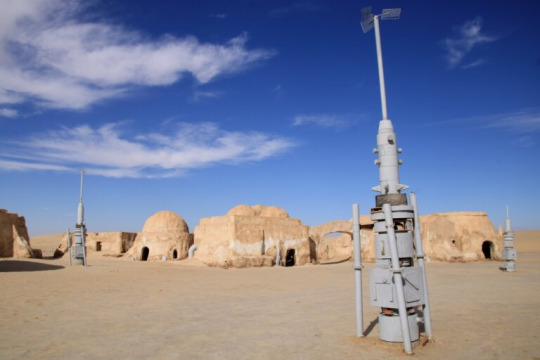
Pictured: Moisture vaporators on the largely abandoned Star Wars film set of Mos Espa, in Tunisia
If science fiction authors could come up with the particulars of such a device, Shrivastav must have felt his had a good chance of succeeding. He and colleagues Govinda Balaji and Venkatesh Raja founded Uravu Labs, a Bangalore-based startup in 2019.
Their initial offering is a machine that converts air to water using a liquid desiccant. Absorbing moisture from the air, sunlight or renewable energy heats the desiccant to around 100°F which releases the captured moisture into a chamber where it’s condensed into drinking water.
The whole process takes 12 hours but can produce a staggering 2,000 liters, or about 500 gallons of drinking-quality water per day. [Note: that IS staggering! That's huge!!] Uravu has since had to adjust course due to the cost of manufacturing and running the machines—it’s just too high for civic use with current materials technology.
“We had to shift to commercial consumption applications as they were ready to pay us and it’s a sustainability driver for them,” Shrivastav explained. This pivot has so far been enough to keep the start-up afloat, and they produce water for 40 different hospitality clients.
Looking ahead, Shrivastav, Raja, and Balaji are planning to investigate whether the desiccant can be made more efficient; can it work at a lower temperature to reduce running costs, or is there another material altogether that might prove more cost-effective?
They’re also looking at running their device attached to data centers in a pilot project that would see them utilize the waste heat coming off the centers to heat the desiccant."
-via Good News Network, May 30, 2024
#water#india#kerala#Kozhikode#science and technology#clean water#water access#drinking water#drought#climate change#climate crisis#climate action#climate adaptation#green tech#sustainability#water shortage#good news#hope#star wars#tatooine
1K notes
·
View notes
Text
Indian IT Worker Designs New Eco-Friendly Sewage Treatment Method with the Sacred Cow as His Inspiration https://www.goodnewsnetwork.org/indian-it-worker-designs-new-eco-friendly-sewage-treatment-method-with-the-sacred-cow-as-his-inspiration/
Tharun Kumar began to imagine ways to build a better sewage treatment method that could produce good quality water without chemicals.
In 2017, Kumar started ECOSTP with the chambered stomach of the cow as his “bovine inspiration.”
Typical wastewater plants use aerobic bacteria, or metabolism with oxygen, to break down sewage, but this requires the ventilation system that continually runs on energy. Regular sewage treatment also tends to use chemicals, and has the presence of a full-time employee. Kumar has eliminated almost all of these drawbacks.
At the base of the ECOSTP septic tank is a layer of cow dung that provides the bacterial workers. With the water moving via gravity, it enters the second bacterial chamber before passing into the third space which is a filter of sand and gravel. The fourth chamber lies under a garden of select vascular plants which removes suspended solids, pathogens, nitrogen, and phosphorus, the latter two going to feed the plants.
The resulting water is graded by health inspectors as good quality for toilet water and gardening applications. With the aid of a grant from the US-based Biomimicry Solutions, ECOSTP now has 325 clients across 22 states in India, and their septic tanks are unmanned and unpowered, saving thousands in running costs.
“We are proud to have reclaimed 2 billion liters of sewage so far without power or chemicals.”
ECOSTP is now seeing if it’s possible to identify anaerobic bacteria that can remove the harmful compounds of industrial effluent.
youtube
#good news#science#microbiology#india#waste water treatment#wastewater#green technology#biomimicry#environmentalism#environment#nature#animals#climate change#climate crisis#Youtube
256 notes
·
View notes
Text
The Rājarājeśvaram temple of Dārāsuram in India, demonstrates an exceptional level of ornamentation, achieving a tasteful balance without becoming indulgent.

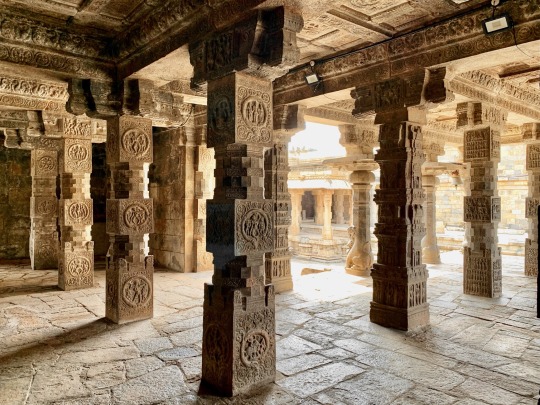
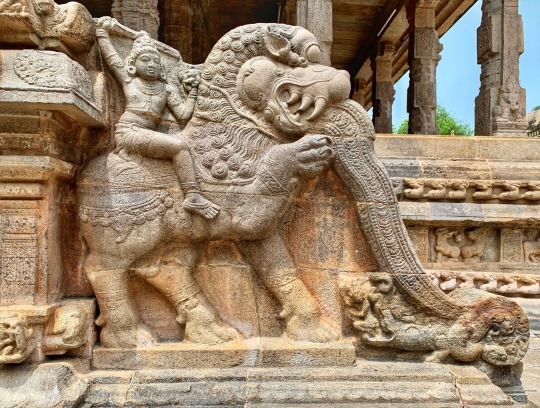

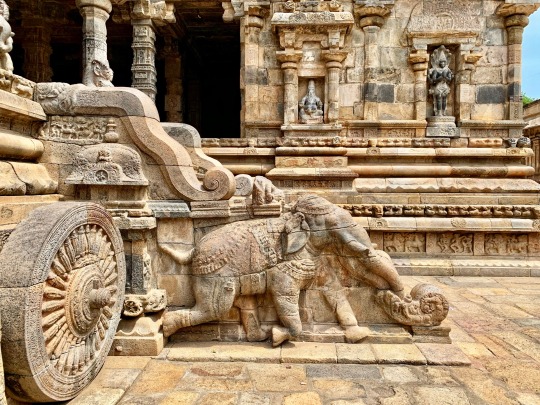

#india#tumblr#marvellous#aesthetic#architecture#beautiful#temple#art#ancient#hinduism#carvings#old#carved#ancient history#technology#history#futurism
790 notes
·
View notes
Text
A walk through Bengal's architecture
Bengali architecture has a long and rich history, fusing indigenous elements from the Indian subcontinent with influences from other areas of the world. Present-day Bengal architecture includes the nation of Bangladesh as well as the Indian states of West Bengal, Tripura, and Assam's Barak Valley. West Bengal’s architecture is an amalgamation of ancient urban architecture, religious architecture, rural vernacular architecture, colonial townhouses and country houses, and modern urban styles. Bengal architecture is the architecture of Wind, Water, and Clay. The Pala Empire (750–1120), which was founded in Bengal and was the final Buddhist imperial force on the Indian subcontinent, saw the apex of ancient Bengali architecture. The majority of donations went to Buddhist stupas, temples, and viharas. Southeast Asian and Tibetan architecture was influenced by Pala architecture. The Grand Vihara of Somapura, which is now a UNESCO World Heritage Site, was the most well-known structure erected by the Pala rulers.

The Grand Vihara of Somapura
According to historians, the builders of Angkor Wat in Cambodia may have taken inspiration from Somapura. Bengal architecture became known for its use of terracotta due to the scarcity of stone in the area. Clay from the Bengal Delta was used to make bricks.
The temple architecture has distinct features like the rich wall decoration, often known as the terracotta temples, which was one of the remarkable elements of Bengali temple architecture. The double-roofed architecture of thatched huts was replicated by Bengali temples. Square platforms were used to construct the temples. Burnt brick panels with figures in geometric patterns or substantial sculptural compositions served as the temples' adornment.

Dochala style
These served as models for many temples that were built in undivided Bengal. Construction materials used in ancient times included wood and bamboo. Bengal has alluvial soil, so there isn't a lot of stone there. The bricks that were utilized to build the architectural components were made from stone, wood, black salt, and granite. Bengal has two different types of temples: the Rekha type, which is smooth or ridged curvilinear, and the Bhadra form, which has horizontal tiers that gradually get smaller and is made up of the amalaka sila. Mughal architecture, including forts, havelis, gardens, caravanserais, hammams, and fountains, spread throughout the area during the Mughal era in Bengal. Mosques built by the Mughals in Bengal also took on a distinctive regional look. The two major centers of Mughal architecture were Dhaka and Murshidabad. The do-chala roof custom from North India was imitated by the Mughals.

Jorasako thakurbari
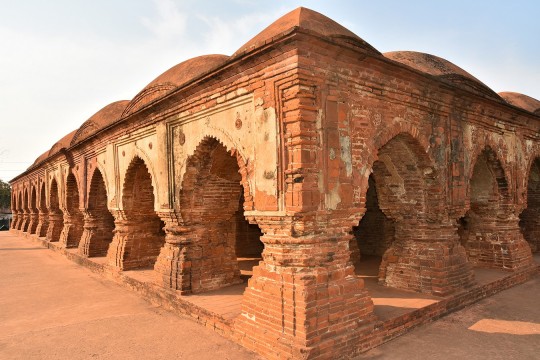
The Rasmancha is a heritage building located at Bishnupur, Bankura district, West Bengal.
Influence of the world on Bengal architecture: Although the Indo-Saracenic architectural style predominated in the area, Neo-Classical buildings from Europe were also present, particularly in or close to trading centers. While the majority of country estates had a stately country house, Calcutta, Dacca, Panam, and Chittagong all had extensive 19th and early 20th-century urban architecture that was equivalent to that of London, Sydney, or other British Empire towns. Calcutta experienced the onset of art deco in the 1930s. Indo-Saracenic architecture can be seen in Ahsan Manzil and Curzon Hall in Dhaka, Chittagong Court Building in Chittagong, and Hazarduari Palace in Murshidabad.
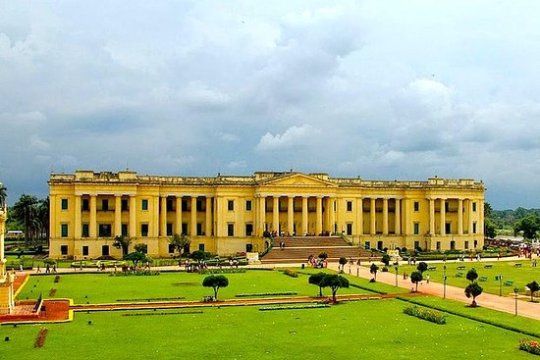
Hazarduari Palace in Murshidabad
The Victoria Memorial in Kolkata, designed by Vincent Esch also has Indo-Saracenic features, possibly inspired by the Taj Mahal. Additionally, Kolkata's bungalows, which are being demolished to make way for high-rise structures, have elements of art deco. The 1950s in Chittagong saw a continuation of Art Deco influences. The Bengali modernist movement, spearheaded by Muzharul Islam, was centered in East Pakistan. In the 1960s, many well-known international architects, such as Louis Kahn, Richard Neutra, Stanley Tigerman, Paul Rudolph, Robert Boughey, and Konstantinos Doxiadis, worked in the area.

The Jatiyo Sangshad Bhaban
This iconic piece of contemporary Bangladeshi architecture, was created by Louis Kahn. Midsized skyscrapers dominate the cityscapes of contemporary Bengali cities, which are frequently referred to as "concrete jungles." With well-known architects like Rafiq Azam, architecture services play a key role in the urban economies of the area. Overall Bengal architecture was influenced by various contemporaries of their time and continues to evolve.

Gothic architectural style seen in St. Paul's Cathedral in Kolkata.

Zamindar era buildings in ruin.

Belur Math in Howrah
#bengali#bangla#west bengal#bangladesh#tripura#assam#desi#বাংলা#india#architecture#tales#bengal architecture#history#kolkata#international#technology#information#temple#asia#bricks
183 notes
·
View notes
Text
India has warned tech companies that it is prepared to impose bans if they fail to take active measures against deepfake videos, a senior government minister said, on the heels of warning by a well-known personality over a deepfake advertisement using his likeness to endorse a gaming app.
The stern warning comes as New Delhi follows through on advisory last November of forthcoming regulations to identify and restrict propagation of deepfake media. Rajeev Chandrasekhar, Deputy IT Minister, said the ministry plans to amend the nation’s IT Rules by next week to establish definitive laws counteracting deepfakes. He expressed dissatisfaction with technology companies’ adherence to earlier government advisories on manipulative content.
Continue Reading.
76 notes
·
View notes
Note
PLEASSEEE TELL US ABOUT YOUR MYTHIC MUMBATTAN AU PLEASE PLEASEE



>:) very well, my people
(currently screaming because i wrote a response but i accidentally CTRL+Zd everything out of existence lmao)

The Mythic Mumbattan AU is me pouring the following ingredients into an explosive mess:
Hindu mythology and Indian culture overload
college!Spider-Man shenanigans
revamping the original Spider-Man: India plotlines and expanding the lore
character studies!!! my favourite :)
a potential and self-indulgent crossover with another indian superhero (if we ever get there)
the horrors.
Pavitr and his personal cast!!! just!!!! THEY!!!!!!
(keep reading if you want more goodies >:D)
So the CoffeeBean is a coffeeshop that existed in the mainstream Marvel universe and in real life but that's another thing; the cast below frequently drop by to hang out with one another. The Mumbattan-equivalent of the CoffeeBean is actually the TeaHouse which is another real life thing but shh and so in-universe they're called the TeaHouse gang, but in my heart they'll always be the CBG 😌
Everyone goes to Brihanmumbai State University (BSU). Lots of crazy things happen here. Pavitr's relationship with the others is always in flux but ultimately they're super close with one another (fuck it, they might as well be poly). Their personalities I try to keep as close as I can to the mainstream universe E616 comics, but I'm being creative and letting a few things from the SMI comics and ATSV influence them:
Pavitr Prabhakar — Tamilar (Tamil); he has the charm and skills from his ATSV counterpart and the smarts from his SMI counterpart; he can be a bit of a jerk and a flake, but he tries to be a good friend, and is much more open than he was in high school.
Meera Jain — Kannadiga (Kannada); basically how I've written her in tibim: everyone's first impression of her is that she's carefree and seems to not worry too much about life. She secretly deals with a lot of self-doubt and personal fears, but the gang's presence is enough for her to push them aside.
Gayatri Singh — Gujarati (Gujarati); she's probably the most quiet of the gang, but undeniably the kindest. She's more similar to Pavitr, in that she's stubborn and quick to judge. She's the glue of the gang and always willing to extend a hand to others
Hari Oberoi — Maharashtrian (Gujarati/Marathi/Hindi); the son of the man who tried to bring literal hell to earth, but other than that he's okay. He's a people-pleaser despite having everything, and struggles with his own self-image and who he should become
Ekansh "Flash" Travasso — Goan (Marathi); the high school jock who's grown more understanding and compassionate. He knew Pavitr the longest, so they have quite an interesting collection of interactions. (ALSO I'M SO SORRY I WROTE THOMPSON IN THE ART POST INSTEAD OF TRAVASSO 😭 maybe i should go back and edit that)
Spider-Man is Spider-Man'ing. Mumbattan loves him (sort of. Inspector Singh has mixed feelings). But another question: why is that every where Spider-Man goes the demons of yore all start showing up and begin wrecking havoc? Why is that? I am taking the magic in Spider-Man: India and dialing it up to five million — horrors and magic of every kind! I can get my hands real dirty and /really/ push Pavitr to his limit >:)
That is all for now. There will be more characters, but they'll show up in time. Lots of stories too, all old and new and revamped and crazy, but they'll be told when they're ready. Perhaps this is enough to satiate everyone's hunger? (unless you want to know something else, then by all means go ahead and ask!!!)
#sorry this took so long i was procrastinating#and then all my words disappeared and i had to physically go and touch grass. sometimes technology and i don't mix#but anyway#mythic mumbattan au#my beloved#i am soooooo insane about these guys. you have no idea#me waiting for all the words to come pouring out of my brain ykykyk#coffee bean gang#spider man#pavitr prabhakar#gayatri singh#meera jain#hari oberoi#flash travasso#spider man india#agni of wisdom#agnirambles
165 notes
·
View notes
Text

Indian Navy aircraft carrier INS Vikrant, 1971.
76 notes
·
View notes
Text

SUMMARY: A man experiences a supernatural occurrence at his newly purchased apartment: a soap opera being telecast exclusively on his TV, which shows the future of his family.
#13b: fear has a new address (2009)#supernatural horror#technological horror#2000s#india#asian movie#horror#movie#poll
15 notes
·
View notes
Text
#code#collage#developers & startups#programming#sociology#robotics#technology#ux#tv#tech#india#indonesien#pakistan#islamic#black friday#obey me shall we date#marriage#beauty
41 notes
·
View notes
Text

Seal in freshness with every pouch of oil-based laundry soap - #CleanRevolution #EcoWash #PackagingInnovation #SustainableSuds #PouchPower #LiveMachineryVideos
#atommachinerymfgco#atomsoapmachine#atomsoapplodder#atomsoapsigmamixer#atomtriplerollmill#india#http://atomgroups.trustpass.alibaba.com#technology#health#nutrition
19 notes
·
View notes
Text

The CEO of oceangate , stockton rush, is married to Wendy Rush, the great-great-granddaughter of Isidor and Ida Straus, who tragically died on the titanic .
The couple chose to stay together on the sinking ship so that others could be saved. Wendy Rush is a descendant of Minnie Weil, one of the Straus" children. The connection between the CEO's wife and the famous couple was confirmed through genealogical records and has brought attention to the ongoing search for OceanGate's missing submersible near the Titanic wreck.
#titanic#oceangate#surya#kulshreshtha#surya kulshreshtha#technology#suryakulshreshtha#life#programming#coding#india#android
93 notes
·
View notes
Text
Scientists have developed a new solar-powered system to convert saltwater into fresh drinking water which they say could help reduce dangerous the risk of waterborne diseases like cholera.
Via tests in rural communities, they showed that the process is more than 20% cheaper than traditional methods and can be deployed in rural locations around the globe.
Building on existing processes that convert saline groundwater to freshwater, the researchers from King’s College London, in collaboration with MIT and the Helmholtz Institute for Renewable Energy Systems, created a new system that produced consistent levels of water using solar power, and reported it in a paper published recently in Nature Water.
It works through a process called electrodialysis which separates the salt using a set of specialized membranes that channel salt ions into a stream of brine, leaving the water fresh and drinkable. By flexibly adjusting the voltage and the rate at which salt water flowed through the system, the researchers developed a system that adjusts to variable sunshine while not compromising on the amount of fresh drinking water produced.
Using data first gathered in the village of Chelleru near Hyderabad in India, and then recreating these conditions of the village in New Mexico, the team successfully converted up to 10 cubic meters, or several bathtubs worth of fresh drinking water. This was enough for 3,000 people a day with the process continuing to run regardless of variable solar power caused by cloud coverage and rain.
[Note: Not sure what metric they're using to calculate daily water needs here. Presumably this is drinking water only.]
Dr. Wei He from the Department of Engineering at King’s College London believes the new technology could bring massive benefits to rural communities, not only increasing the supply of drinking water but also bringing health benefits.
“By offering a cheap, eco-friendly alternative that can be operated off the grid, our technology enables communities to tap into alternative water sources (such as deep aquifers or saline water) to address water scarcity and contamination in traditional water supplies,” said He.
“This technology can expand water sources available to communities beyond traditional ones and by providing water from uncontaminated saline sources, may help combat water scarcity or unexpected emergencies when conventional water supplies are disrupted, for example like the recent cholera outbreaks in Zambia.”
In the global rural population, 1.6 billion people face water scarcity, many of whom are reliant on stressed reserves of groundwater lying beneath the Earth’s surface.
However, worldwide 56% of groundwater is saline and unsuitable for consumption. This issue is particularly prevalent in India, where 60% of the land harbors undrinkable saline water. Consequently, there is a pressing need for efficient desalination methods to create fresh drinking water cheaply, and at scale.
Traditional desalination technology has relied either on costly batteries in off-grid systems or a grid system to supply the energy necessary to remove salt from the water. In developing countries’ rural areas, however, grid infrastructure can be unreliable and is largely reliant on fossil fuels...
“By removing the need for a grid system entirely and cutting reliance on battery tech by 92%, our system can provide reliable access to safe drinking water, entirely emission-free, onsite, and at a discount of roughly 22% to the people who need it compared to traditional methods,” He said.
The system also has the potential to be used outside of developing areas, particularly in agriculture where climate change is leading to unstable reserves of fresh water for irrigation.
The team plans to scale up the availability of the technology across India through collaboration with local partners. Beyond this, a team from MIT also plans to create a start-up to commercialize and fund the technology.
“While the US and UK have more stable, diversified grids than most countries, they still rely on fossil fuels. By removing fossil fuels from the equation for energy-hungry sectors like agriculture, we can help accelerate the transition to Net Zero,” He said.
-via Good News Network, April 2, 2024
#water#water scarcity#clean water#saline#desalination#off grid#battery technology#solar power#solar energy#fossil fuels#water shortage#india#hyderabad#new mexico#united states#uk#united kingdom#good news#hope#aquifers
993 notes
·
View notes
Text
Do you know Where I Can Find Happiness?
Navigating the Path to Happiness: A Journey Within
In the hustle and bustle of modern life, the pursuit of happiness has become a universal quest. People often find themselves asking, "Where I can find happiness?" as if it were a tangible destination waiting to be discovered. However, the journey to happiness is more nuanced, often requiring introspection, mindful choices, and a recognition that joy is a subjective and multifaceted experience.

The Illusion of External Fulfillment
In a world driven by materialism and external achievements, it's easy to fall into the trap of seeking happiness in possessions, status, or external validation. Many individuals believe that acquiring more wealth, achieving certain milestones, or gaining societal approval will unlock the door to lasting happiness. However, this pursuit often proves elusive, leaving individuals feeling unfulfilled and yearning for more.
Cultivating Happiness from Within
True happiness, however, often lies within. It involves a journey of self-discovery, where individuals explore their values, passions, and innermost desires. Cultivating a sense of purpose and aligning one's life with personal values can be a powerful foundation for sustainable happiness.
1. Mindfulness and Present Living: Happiness is often found in the present moment. Embracing mindfulness – the practice of being fully present and engaged in the current experience – allows individuals to savor life's simple pleasures, fostering a deeper sense of contentment.
2. Connection and Relationships: Meaningful connections with others contribute significantly to happiness. Building and nurturing positive relationships with friends, family, and the community can provide a sense of belonging and support, enhancing overall well-being.
3. Gratitude Practice: Gratitude is a powerful tool in the pursuit of happiness. Taking time each day to reflect on the positive aspects of life, no matter how small, can shift focus from what's lacking to what is abundant, fostering a more positive mindset.
4. Personal Growth and Learning: Engaging in continuous learning and personal development can bring a sense of accomplishment and fulfillment. Setting and achieving personal goals, no matter how small, contributes to a sense of purpose and progress.
Seeking Joy in the Journey
Rather than viewing happiness as a distant endpoint, it is crucial to recognize that happiness is often found in the journey itself. Life is a series of moments, and finding joy in the process of living can lead to a more fulfilling and satisfying existence.
1. Embracing Imperfections: Accepting that life is imperfect and embracing the ups and downs allows individuals to navigate challenges with resilience. Happiness is not the absence of difficulties but the ability to find joy despite them.
2. Balancing Work and Play: Striking a balance between work and leisure is essential. Overemphasis on professional success without allocating time for personal interests and recreation can lead to burnout and hinder overall happiness.
3. Self-Compassion: Being kind to oneself is a crucial aspect of happiness. Recognizing and accepting one's flaws and imperfections with self-compassion fosters a positive relationship with oneself.
The Ever-Changing Nature of Happiness
It's essential to acknowledge that happiness is not a static state but a dynamic and evolving experience. What brings joy at one stage of life may not necessarily do so in another. Flexibility and adaptability in the pursuit of happiness allow individuals to navigate life's transitions with resilience and openness.
Conclusion: A Personal Odyssey
In answering the question, "Where can I find happiness?" it becomes evident that the journey is deeply personal. It involves self-reflection, intentional choices, and a willingness to explore the rich tapestry of human experiences. True happiness is not a destination but a continuous exploration of the self and the world, guided by authenticity, gratitude, and a commitment to living a life aligned with one's values. As individuals embark on their personal odyssey towards happiness, they may discover that the destination is not a place but a state of being found within the depths of their own hearts and minds.
Read more information to click given link:
#canada#india#tech#techcore#technews#technically#technoblade#technology#usa#100 days of productivity#seo services#seo#emailmarketing#digital marketing#smm#online marketing#kim seokjin#seonghwa#seo changbin#video games#gamedev#the hunger games#ts4 gameplay#sims 4 gameplay#tag game#gaming#videogame#gamers#steam#viralpage
16 notes
·
View notes
Text
11th century Surya temple of Jhalrapatan.
Rajasthan, India

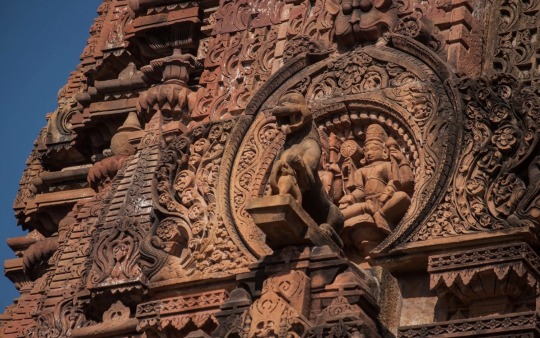

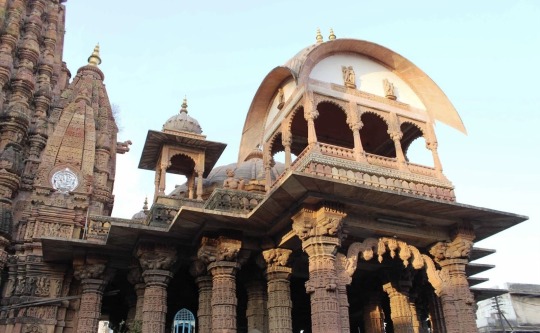
#india#tumblr#marvellous#aesthetic#architecture#beautiful#temple#art#futurism#love#ancient#hinduism#carvings#old#carved#bharat#ancient history#technology#colorful#history
250 notes
·
View notes
Text
In India, where many rural women still plaster the walls and build stoves using a composite of mud and cow dung, they sometimes add hairs to bind and strengthen the mixture. What is remarkable is just how many of these apparently ‘folk uses’ of hair are today being taken up by designers and engineers interested in developing sustainable technologies. Recent experiments by geoscientists and engineers in Australia and India suggest that human hair, owing to its high tensile strength, is highly effective for reinforcing asphalt in roads and for blocking the development of microscopic cracks in concrete when mixed in the right proportions.
4 notes
·
View notes